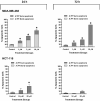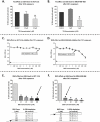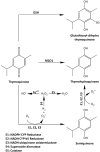Concurrent Reactive Oxygen Species Generation and Aneuploidy Induction Contribute to Thymoquinone Anticancer Activity
- PMID: 34500570
- PMCID: PMC8433634
- DOI: 10.3390/molecules26175136
Concurrent Reactive Oxygen Species Generation and Aneuploidy Induction Contribute to Thymoquinone Anticancer Activity
Abstract
Thymoquinone (TQ) is the main biologically active constituent of Nigella sativa. Many studies have confirmed its anticancer actions. Herein, we investigated the different anticancer activities of, and considered resistance mechanisms to, TQ. MTT and clonogenic data showed TQ's ability to suppress breast MDA-MB-468 and T-47D proliferation at lower concentrations compared to other cancer and non-transformed cell lines tested (GI50 values ≤ 1.5 µM). Flow-cytometric analyses revealed that TQ consistently induced MDA-MB-468 and T-47D cell-cycle perturbation, specifically inducing pre-G1 populations. In comparison, less sensitive breast MCF-7 and colon HCT-116 cells exhibited only transient increases in pre-G1 events. Annexin V/PI staining confirmed apoptosis induction in MDA-MB-468 and HCT-116 cells, which was continuous in the former and transient in the latter. Experiments revealed the role of reactive oxygen species (ROS) generation and aneuploidy induction in MDA-MB-468 cells within the first 24 h of treatment. The ROS-scavenger NAD(P)H dehydrogenase (quinone 1) (NQO1; DT-diaphorase) and glutathione (GSH) were implicated in resistance to TQ. Indeed, western blot analyses showed that NQO1 is expressed in all cell lines in this study, except those most sensitive to TQ-MDA-MB-468 and T-47D. Moreover, TQ treatment increased NQO1 expression in HCT-116 in a concentration-dependent fashion. Measurement of GSH activity in MDA-MB-468 and HCT-116 cells found that GSH is similarly active in both cell lines. Furthermore, GSH depletion rendered these cells more sensitive to TQ's antiproliferative actions. Therefore, to bypass putative inactivation of the TQ semiquinone metabolite, the benzylamine analogue was designed and synthesised following modification of TQ's carbon-3 atom. However, the structural modification negatively impacted potency against MDA-MB-468 cells. In conclusion, we disclose the following: (i) The anticancer activity of TQ may be a consequence of ROS generation and aneuploidy; (ii) Early GSH depletion could substantially enhance TQ's anticancer activity; (iii) Benzylamine substitution at TQ's carbon-3 failed to enhance anticancer activity.
Keywords: GSH depletion; ROS generation; aneuploidy; apoptosis; thymoquinone.
Conflict of interest statement
The authors of this work declare that there is no conflict of interest.
Figures













Similar articles
-
NADPH quinone oxidoreductase 1 mediates breast cancer cell resistance to thymoquinone-induced apoptosis.Biochem Biophys Res Commun. 2012 Sep 28;426(3):421-6. doi: 10.1016/j.bbrc.2012.08.111. Epub 2012 Aug 30. Biochem Biophys Res Commun. 2012. PMID: 22960073
-
Molecular targeting of Akt by thymoquinone promotes G(1) arrest through translation inhibition of cyclin D1 and induces apoptosis in breast cancer cells.Life Sci. 2013 Nov 13;93(21):783-90. doi: 10.1016/j.lfs.2013.09.009. Epub 2013 Sep 15. Life Sci. 2013. PMID: 24044882
-
Thymoquinone inhibits tumor growth and induces apoptosis in a breast cancer xenograft mouse model: the role of p38 MAPK and ROS.PLoS One. 2013 Oct 2;8(10):e75356. doi: 10.1371/journal.pone.0075356. eCollection 2013. PLoS One. 2013. PMID: 24098377 Free PMC article.
-
Molecular Mechanisms of Thymoquinone as Anticancer Agent.Comb Chem High Throughput Screen. 2021;24(10):1644-1653. doi: 10.2174/1386207323999201027225305. Comb Chem High Throughput Screen. 2021. PMID: 33115388 Review.
-
Molecular Mechanisms and Signaling Pathways Underlying the Therapeutic Potential of Thymoquinone Against Colorectal Cancer.Molecules. 2024 Dec 14;29(24):5907. doi: 10.3390/molecules29245907. Molecules. 2024. PMID: 39769996 Free PMC article. Review.
Cited by
-
Natural anticancer agents: prospection of medicinal and aromatic plants in modern chemoprevention and chemotherapy.Nat Prod Bioprospect. 2025 Apr 21;15(1):25. doi: 10.1007/s13659-025-00511-0. Nat Prod Bioprospect. 2025. PMID: 40257645 Free PMC article. Review.
-
Conofolidine: A Natural Plant Alkaloid That Causes Apoptosis and Senescence in Cancer Cells.Molecules. 2024 Jun 4;29(11):2654. doi: 10.3390/molecules29112654. Molecules. 2024. PMID: 38893527 Free PMC article.
-
Utilization of Nanotechnology to Improve Bone Health in Osteoporosis Exploiting Nigella sativa and Its Active Constituent Thymoquinone.Bioengineering (Basel). 2022 Nov 1;9(11):631. doi: 10.3390/bioengineering9110631. Bioengineering (Basel). 2022. PMID: 36354542 Free PMC article. Review.
-
Nutraceutical Prevention of Diabetic Complications-Focus on Dicarbonyl and Oxidative Stress.Curr Issues Mol Biol. 2022 Sep 18;44(9):4314-4338. doi: 10.3390/cimb44090297. Curr Issues Mol Biol. 2022. PMID: 36135209 Free PMC article. Review.
-
Thymoquinone Enhances Doxorubicin Efficacy via RAS/RAF Pathway Modulation in Ovarian Adenocarcinoma.Pharmaceutics. 2025 Apr 19;17(4):536. doi: 10.3390/pharmaceutics17040536. Pharmaceutics. 2025. PMID: 40284530 Free PMC article.
References
MeSH terms
Substances
Grants and funding
LinkOut - more resources
Full Text Sources
Research Materials
Miscellaneous

